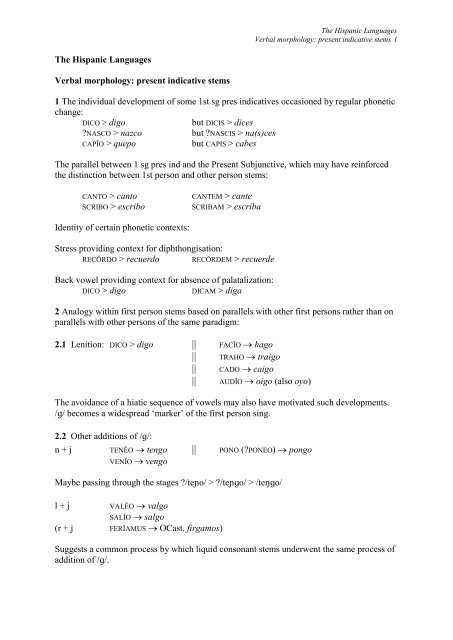Page 1 The Hispanic Languages Verbal morphology: present ...
Page 1 The Hispanic Languages Verbal morphology: present ...
Page 1 The Hispanic Languages Verbal morphology: present ...
Create successful ePaper yourself
Turn your PDF publications into a flip-book with our unique Google optimized e-Paper software.
<strong>The</strong> <strong>Hispanic</strong> <strong>Languages</strong><br />
<strong>Verbal</strong> <strong>morphology</strong>: <strong>present</strong> indicative stems<br />
<strong>The</strong> <strong>Hispanic</strong> <strong>Languages</strong><br />
<strong>Verbal</strong> <strong>morphology</strong>: <strong>present</strong> indicative stems 1<br />
1 <strong>The</strong> individual development of some 1st sg pres indicatives occasioned by regular phonetic<br />
change:<br />
DICO > digo but DICIS > dices<br />
?NASCO > nazco but ?NASCIS > na(s)ces<br />
CAPĬO > quepo but CAPIS > cabes<br />
<strong>The</strong> parallel between 1 sg pres ind and the Present Subjunctive, which may have reinforced<br />
the distinction between 1st person and other person stems:<br />
CANTO > canto CANTEM > cante<br />
SCRIBO > escribo SCRIBAM > escriba<br />
Identity of certain phonetic contexts:<br />
Stress providing context for diphthongisation:<br />
RECŎRDO > recuerdo RECŎRDEM > recuerde<br />
Back vowel providing context for absence of palatalization:<br />
DICO > digo DICAM > diga<br />
2 Analogy within first person stems based on parallels with other first persons rather than on<br />
parallels with other persons of the same paradigm:<br />
2.1 Lenition: DICO > digo || FACĬO → hago<br />
|| TRAHO → traigo<br />
|| CADO → caigo<br />
|| AUDĬO → oigo (also oyo)<br />
<strong>The</strong> avoidance of a hiatic sequence of vowels may also have motivated such developments.<br />
// becomes a widespread ‘marker’ of the first person sing.<br />
2.2 Other additions of //:<br />
n + j TENĔO → tengo || PONO (?PONEO) → pongo<br />
VENĬO → vengo<br />
Maybe passing through the stages ?/teo/ > ?/teo/ > /teo/<br />
l + j VALĔO → valgo<br />
SALĬO → salgo<br />
(r + j FERĬAMUS → OCast. firgamos)<br />
Suggests a common process by which liquid consonant stems underwent the same process of<br />
addition of //.
2.3 Palatalization:<br />
d + j VIDĔO → veo<br />
<strong>The</strong> <strong>Hispanic</strong> <strong>Languages</strong><br />
<strong>Verbal</strong> <strong>morphology</strong>: <strong>present</strong> indicative stems 2<br />
SEDĔAM → sea || VADAM → vaya<br />
but VADO → *vao → vo → voy<br />
g + j FUGĬO → huyo<br />
b + j HABĔAM > haya but HABĔO → he<br />
2.4 Metaphony:<br />
p + j CAPĬO > quepo<br />
SAPĬAM > sepa but SAPĬO → sé<br />
2.5 Monosyllabic forms:<br />
DO → doy<br />
STO → estoy<br />
SUM → soy<br />
VADO → voy<br />
2.6 ‘Inchoative’ suffix:<br />
?MERESCO > merezco || LUCĔO → luzco<br />
?NASCO > nazco<br />
and general extension to all verbs in -ecer and -ucir.<br />
2.7 Evidence of continuing variation:<br />
roer raigo || caer<br />
roigo || oir<br />
roo || comer<br />
royo || vaya<br />
yacer yazco || nazco<br />
yazgo ||<br />
yago || hago<br />
asir aso<br />
asgo<br />
asco<br />
haber haya || vaya<br />
haiga || caiga<br />
cocer cuezo<br />
cuezgo<br />
cuego || digo<br />
Further reading:<br />
Malkiel, Yakov, ‘New Problems in Romance Interfixation (I): <strong>The</strong> Velar Insert in the Present Tense (with an<br />
excursus on -zir/-zer verbs)’, Romance Philology, 27 (1973-74), 304-55.
















